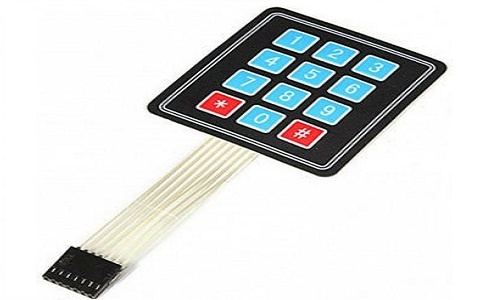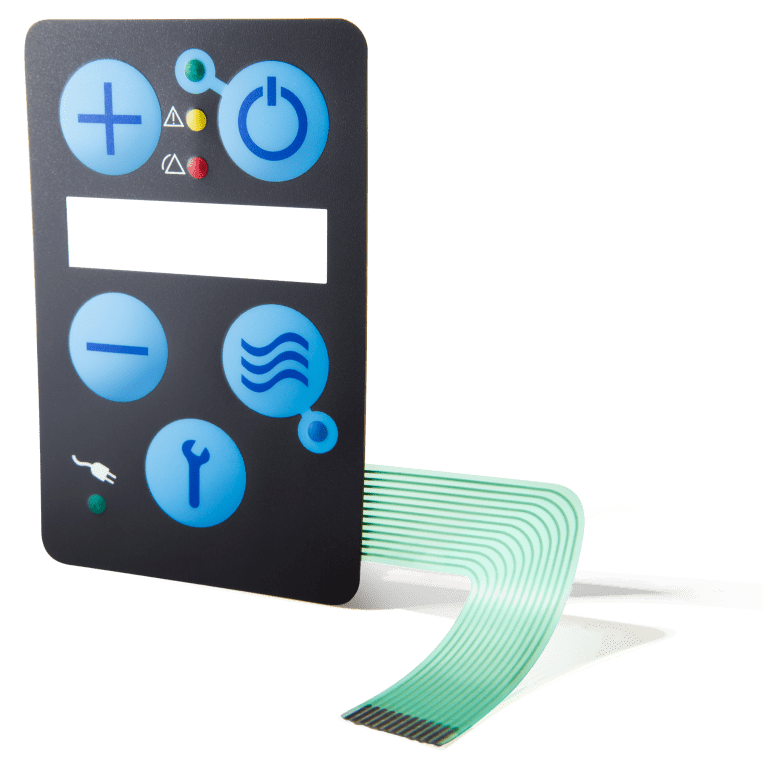All Regarding Membrane layer Change: A Comprehensive Overview for Beginners
Membrane buttons are crucial elements in modern-day electronics, using a distinct user interface for customer interaction - membrane switch. Their split construction, including overlays and conductive traces, gives functionality and longevity. Unlike conventional mechanical buttons, membrane switches provide a streamlined layout and adjustable choices. Recognizing their essential functions and advantages can transform product style. The details of their application and design considerations call for additional expedition.
What Is a Membrane layer Change?
A membrane layer button is a kind of electric button that contains an adaptable membrane layer layered over a printed circuit card. This style enables a smooth and small interface, commonly made use of in numerous digital gadgets. Membrane switches are commonly found in customer devices, clinical devices, and industrial machinery due to their resilience and resistance to environmental factors.The building generally consists of several layers, such as graphic overlays and adhesive support, which give responsive feedback and safeguard the circuitry underneath. The procedure of a membrane switch is launched when stress is applied to the surface area, finishing an electrical circuit.These buttons are valued for their adaptability, allowing custom layouts and printed graphics that accommodate certain individual interfaces. Their inconspicuous nature minimizes area needs, making them suitable for applications where conventional buttons may not fit. Overall, membrane switches offer a useful and aesthetic solution for contemporary digital gadgets.
Trick Parts of Membrane Switches Over
Membrane changes consist of a number of vital elements that add to their performance and efficiency. The top layer, understood as the overlay, provides the customer interface and is typically published with signs or graphics. Beneath the overlay lies a spacer layer, which divides the conductive components and avoids unintentional activation. The following vital element is the visuals layer, which enhances aesthetics and ensures the durability of the design.Conductive traces, normally made from products like silver or carbon, are printed on the circuit layer. When pressure is used to the overlay, these traces enter contact, finishing the circuit. In addition, a support layer offers structural assistance and can be made from products such as polyester or polycarbonate. With each other, these components produce a trusted, user-friendly interface appropriate for different applications, from house devices to industrial equipment. Comprehending these components is essential for anybody interested in membrane button technology.
Exactly How Membrane Layer Switches Job
Recognizing just how membrane switches over function is important for appreciating their extensive usage in numerous devices. A membrane button runs via a series of layers, including a graphic overlay, spacer, and a circuit layer. When stress is related to the overlay, it presses the spacer layer, permitting the circuit layer to make contact and complete an electrical circuit. This action sends out a signal to the tool, motivating a response, such as activating a light or triggering a function.Membrane switches over can be made with various functions, consisting of responsive responses, backlighting, and personalized graphics, boosting user interaction. Their building permits a closed style, safeguarding the interior elements from dust, moisture, and pollutants. This longevity makes them suitable for varied applications, from customer electronic devices to industrial devices. In general, the simplicity and effectiveness of membrane layer switches over add to their appeal in contemporary technology.
Benefits of Membrane Layer Switches Mechanical Buttons
While mechanical switches have actually long been a staple in numerous tools, membrane changes offer distinct benefits that make them significantly appealing. One considerable benefit is their slim profile, permitting for even more small styles and higher versatility in product growth. Furthermore, membrane layer changes feature a consistent surface, which enhances visual charm and simplifies cleansing, making them appropriate for environments where health is critical.Another advantage is their resistance to dust and dampness. Unlike mechanical buttons, which can be jeopardized by environmental aspects, membrane buttons offer a sealed user interface that safeguards against impurities - membrane switch. Membrane layer switches generally have a longer life-span due to fewer relocating parts, resulting in improved resilience and reliability.Cost-effectiveness is likewise a notable benefit, as membrane layer switches can be created in mass with lower production costs. These aspects incorporate to position membrane buttons as a practical option to typical mechanical options in different applications
Usual Applications of Membrane Layer Switches
Membrane buttons are extensively used in different fields, particularly in consumer electronics and industrial control board. In customer tools, they provide a smooth, easy to use user interface, while in commercial setups, they boost resilience and performance. Recognizing these applications highlights the convenience and practicality of membrane switches in modern technology.
Consumer Electronics Gadgets
As customer electronic devices proceed to advance, membrane buttons Resources have actually come to be a preferred choice for a variety of devices due to their versatility and sleek design. These buttons are commonly found in smartphones, tablet computers, and remotes, where room is minimal and aesthetic appeals matter. Their low profile and customizable designs permit suppliers to develop easy to use interfaces that enhance the overall customer experience. In addition, membrane layer switches are frequently used in home appliances such as microwaves and coffee manufacturers, giving user-friendly control choices while resisting dampness and dust. The sturdiness and reliability of membrane layer switches over make them suitable for everyday customer products, ensuring long more life and consistent efficiency. Generally, their integration in customer electronics mirrors a blend of functionality and contemporary design.
Industrial Control Panels
The applications of membrane layer changes expand beyond customer electronics, locating considerable usage in industrial control board. These switches are preferred for their sturdiness and resistance to harsh settings, making them optimal for manufacturing and process control settings. They supply a trustworthy interface for drivers to control equipment, monitor procedures, and change setups. Membrane layer switches can be tailored to suit certain operational demands, incorporating functions like backlighting and responsive comments, improving individual experience. Their inconspicuous style enables combination right into various devices, while their capacity to stand up to spills, dirt, and extreme temperatures assurances long life. Generally, membrane layer buttons contribute to safe and effective operation in commercial applications, demonstrating their flexibility and performance sought after atmospheres.
Factors To Consider for Creating Membrane Changes
When developing membrane switches, picking the right products is vital to assure sturdiness and capability. In addition, recognizing layer arrangement strategies can greatly affect the switch's performance and user experience. These considerations play an essential function in producing efficient and trustworthy membrane layer switch designs.
Material Option Importance
Product option plays an essential duty in the layout and capability of membrane switches. The picked products straight impact the switch's durability, responsive feedback, and total aesthetic. Key factors to consider consist of the substrate, which must provide architectural stability while enabling for flexibility, and the visuals overlay, which requires to be resistant to wear and ecological aspects. Conductive materials should assure trustworthy electric efficiency, while adhesives need to provide solid bonding without jeopardizing the switch's procedure. Furthermore, compatibility with manufacturing procedures and end-user atmospheres is vital; products should withstand differing temperatures, moisture levels, and chemical direct exposure. Eventually, appropriate product choice not just improves the membrane layer switch's efficiency however also adds to its durability and user satisfaction, making it a critical facet of the design procedure.

Layer Arrangement Techniques

Frequently Asked Concerns
For How Long Do Membrane Changes Typically Last?
Membrane buttons usually have a lifespan of 1 to 5 million cycles, depending upon use and environmental conditions. Aspects such as design high quality and operating regularity greatly influence their longevity and overall performance durability.

Can Membrane Switches Be Custom-made for Details Styles?
Membrane buttons can undoubtedly be customized to suit certain designs, permitting varied shapes, shades, and performances. This flexibility enables makers to tailor these buttons to satisfy unique visual and operational needs efficiently.
What Products Are Made Use Of in Membrane Layer Change Construction?
Membrane layer switches are normally constructed utilizing products such as polyester, polycarbonate, and adhesive layers. These materials give resistance, adaptability, and longevity to ecological aspects, ensuring the switches function efficiently in different applications and problems.
Are Membrane Switches Immune or water-proof to Dampness?
Membrane layer buttons can be designed to be moisture-resistant, utilizing specialized products and finishes. Their water resistant abilities depend on construction quality and specific applications, making it important to assess requirements for ideal efficiency in numerous atmospheres.
Exactly How Are Membrane Switches Fixed if Harmed?
Repairing damaged membrane layer switches over normally includes replacing the influenced layer or circuit. Professionals might likewise apply conductive sticky or utilize specialized repair work kits, ensuring capability is brought back without complete substitute of the entire switch setting up. Unlike conventional mechanical switches, membrane layer switches present a streamlined style and customizable alternatives. A membrane button is a type of electric switch that consists of a versatile membrane layered over a published circuit board. The operation of a membrane layer switch is launched when pressure is used to the surface area, completing an electric circuit.These switches are valued for their adaptability, enabling customized styles and printed graphics that provide to specific individual interfaces. While mechanical buttons have actually long been a staple in lots of tools, membrane switches over deal unique benefits that make them progressively appealing. Membrane layer switches commonly have a longer life expectancy due to less moving components, resulting in boosted toughness and reliability.Cost-effectiveness is additionally a noteworthy advantage, as membrane my response switches can be generated in bulk with lower production prices.
Comments on “How membrane switch enables sustainability in electronic product design”